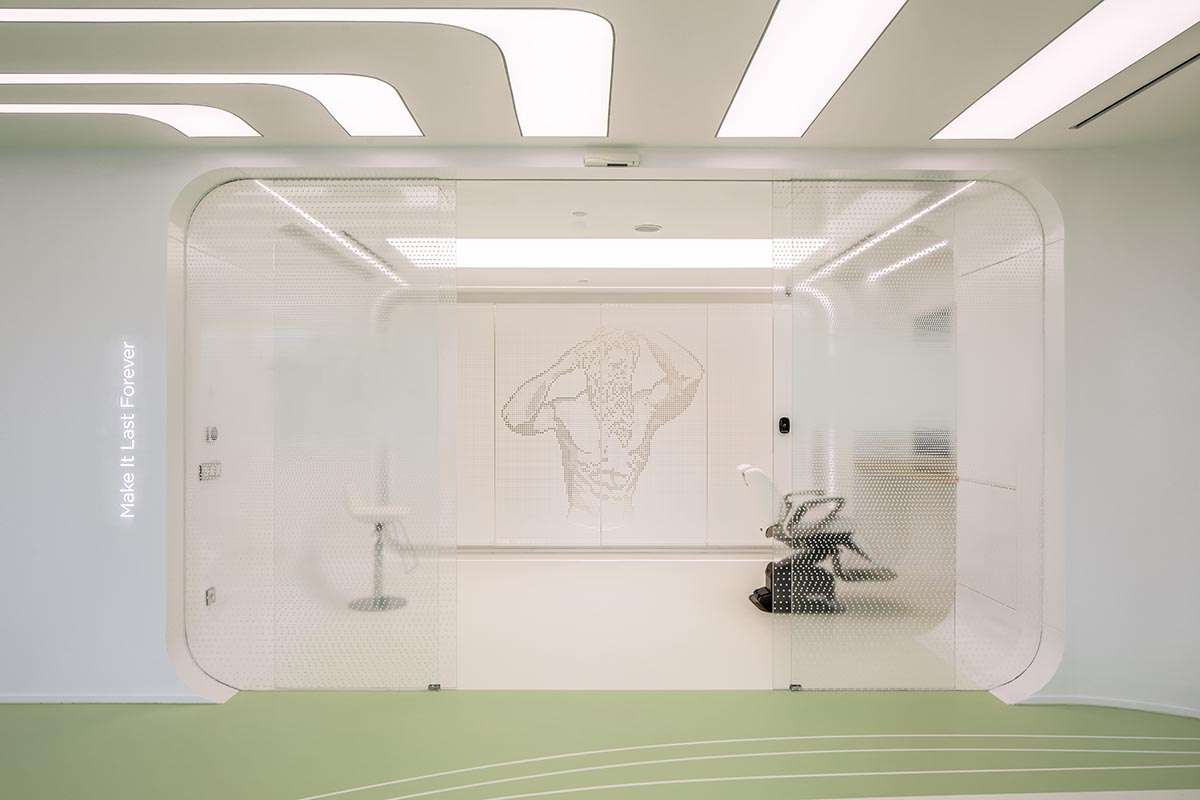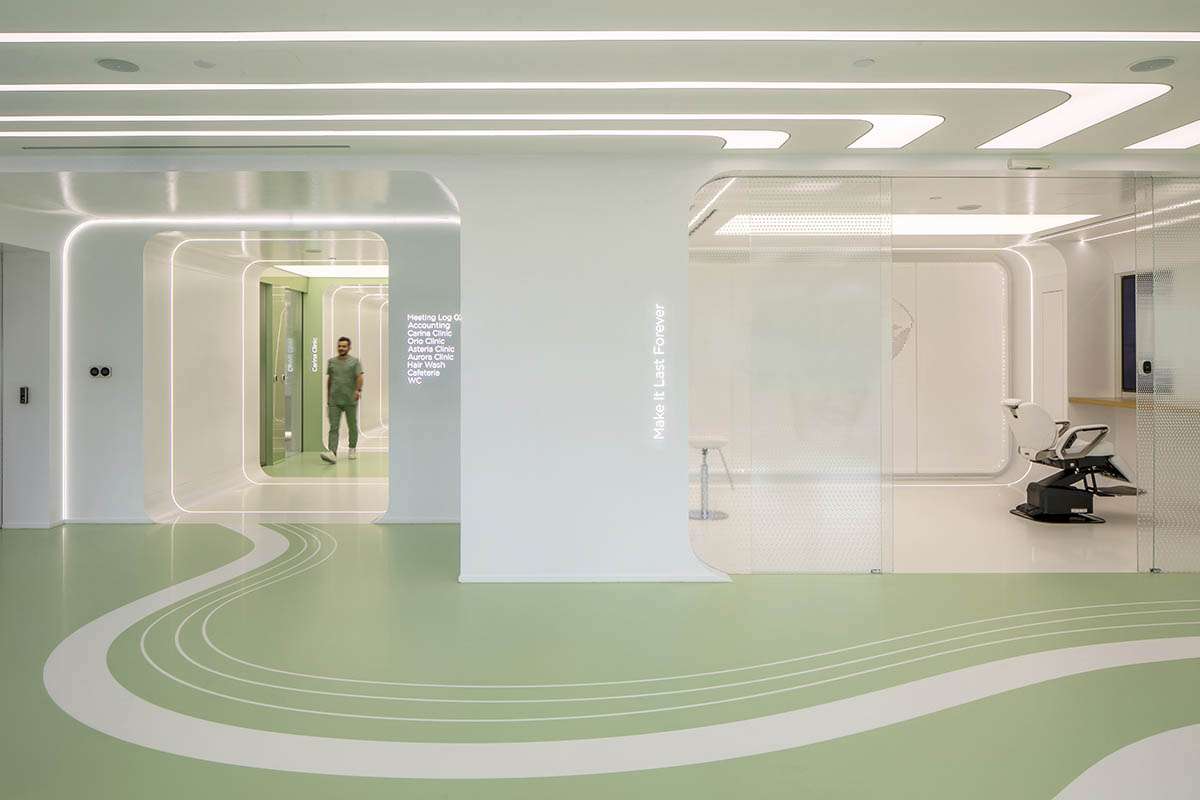Istanbul-based firm Slash Architects designed a hair transplant clinic,
combining technology and elements of nature in fluid lines in Istanbul, Turkey.
The project was called Hair Transplant Clinic and it is located in a residential building in Yalı Ataköy complex on the third floor.
As two apartments are combined on the same floor,
the interior of the clinic covers an area of 450 square meters.
Design features
The design features rich green hues, white curved lines,
and liquid parasol lighting on the ceiling along with a series of artworks.
Slash Architects, led by Şule Ertürk, aims to create a “technological therapy place,”
where technological and natural elements are brought together to create a “digital forest.”
The comprehensive program also includes a lounge, a poetry capsule,
two meeting rooms, a doctor’s office, five clinic rooms, and a coffee shop.
In addition to a hair washing room, a sterilization room, changing and technical rooms,
a kitchen, and an accounting office.
Visitors are surrounded by green
The program elements are connected via a corridor where green capsules envelop the visitor as he moves down the corridor.
The feeling of a sterile environment is also created through a minimalist approach formed around the concept of ‘flat design’,
easy-to-clean surfaces, and the use of white in various materials.
Inside, the use of technology is highlighted by various elements such as sensor doors,
mirror screens, and video walls, in elements that support the operation of a modern health facility.
While architects use the term “forest” to refer to the recovery and growth of a self-renewing ecosystem.
This theme was also included in the project in a way that allows visitors and staff to relax mentally in the hair transplantation clinic,
which can be seen as a space for self-healing.
The team incorporated biophilic design principles into the project, aiming to include nature in space visually, audibly, and tactilely.
The design team broke down the sterile feel of the clinics,
which is both reassuring but also creates cool environments,
by using vibrant green colors, natural materials and living green walls in the main circulation areas and in the rooms where users spend most of their time.
Artwork spread throughout the space
Other important features that make up the third pillar of the concept are the artworks in the interiors.
For example, at the entrance there is a video wall at the entrance and a screen positioned as a curiosity at the end of the corridor, which is to display digital artworks.
In keeping with the clinic’s concept, these artworks supported by soothing sounds will relax visitors while they wait and walk around the clinic.
In addition, two sculptures made specifically for this project are presented at the beginning and end of the corridor,
and all signage and graphic work is considered along with the overall concept.
While the main spaces are arranged in front of the façade,
the secondary service spaces are located close to the core.
For this reason, areas where staff and visitors spend more time receive daylight and natural ventilation is used when needed.
Design of two entrances to the clinic
While the main entrance opens into a large waiting area,
the secondary entrance serves as a service entrance, and the technical volumes are located around it.
Studio outlined a clear and uninterrupted rotation path between these two entrances.
The architects transformed the corridor,
generally designed as dull and monotonous, into an experiment path with something intriguing at the end.
The overall design approach imbued with a sense of technology is also the main tool that shapes the shape of the corridor.
The corridor floor, wall and ceiling are connected seamlessly with the curved surfaces and envelops the visitor like a capsule.
In order to emphasize the form, the corridor lighting is provided with recessed linear lighting placed in the same section.
While this continuous, futuristic-feeling form is interrupted and pulled back in the niches where the entrance doors are located.
These niches are separated from the rest of the corridor by a parisol ceiling,
floor and walls of green color.
The entrances to the rooms are thus shaded,
and throughout this ‘journey’ the visitor is also accompanied by the visual and auditory stimuli of the digital artwork at the end of the corridor.
The entrance foyer is enriched with a digital screen facing the entrance, liquid form parasol lighting on the ceiling, green living wall, heated work desk and ergonomic rest areas.
Hair drawing area, which is considered the “kitchen” for the hair transplant operation, is located just to the right of the entrance.
The drawing room has been made transparent and highlighted as an exhibition space.
Studio applied a semi-opaque film to the glass façade, to ensure privacy,
as this material also helps reflect the impression of movements inside.
To include the brand identity in the project at a minimum,
the logo is transformed into a new graphic work and applied to the metal panels inside the drawing room.

Clinic interior design
In the entrance lobby, a live green wall creates a relaxing feel for visitors,
comfortable armchairs, and a heated desk facing the sea view is in front of the facade.
Considering the results of the pandemic,
the lobby is divided into different areas for individual visitors who wait on their own or family and groups who avoid waiting in a crowded place.
The studio designed the clinic rooms in a simple style.
After the studio examined the mechanism of the hair transplantation process,
it manufactured and added work benches with a cooled surface area in place.
Patient cloakrooms and storage areas containing the various products required for the operation are also equipped with hidden lockers.
The coffee shop is an area designated for employees and visitors,
as it is located in front of the main façade to benefit from natural daylight and a view of the green landscape.
In order to create a warmer and calmer environment, the studio used light green fabrics, natural wood materials, and a living plant wall.
To enhance its relationship with the kitchen and to provide ease of service,
the wall separating the two rooms was designed with a table and a service window.
The team also chose to use long-lasting materials that are resistant to strong chemicals and surfaces that can be cleaned easily, as a necessity for being a healthcare center.
All of these design decisions were brought together for the idea of creating a modern,
digital, comfortable and attractive healthcare center.
For more architectural news








